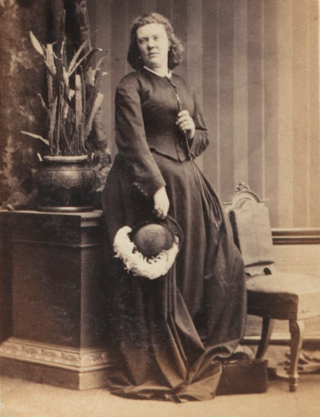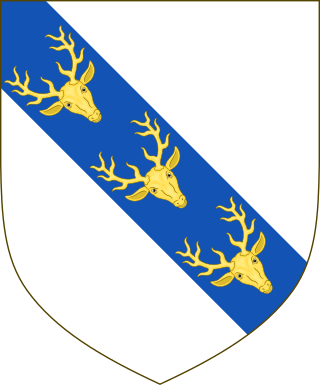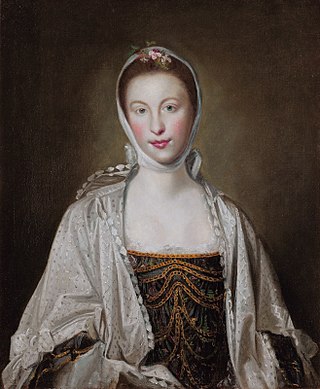
Earl of Loudoun, named after Loudoun in Ayrshire, is a title in the Peerage of Scotland. It was created in 1633 for John Campbell, 2nd Lord Campbell of Loudoun, along with the subsidiary title Lord Tarrinzean and Mauchline. The 1st Earl's wife Margaret was the granddaughter and heiress of Hugh Campbell, who had been created Lord Campbell of Loudoun; he resigned the peerage in favour of his grandson-in-law, who was later created an earl.

Earl of Huntingdon is a title which has been created several times in the Peerage of England. The medieval title was associated with the ruling house of Scotland.

Baron Hastings is a title that has been created three times. The first creation was in the Peerage of England in 1290, and is extant. The second creation was in the Peerage of England in 1299, and became extinct on the death of the first holder in c. 1314. The third creation was in the Peerage of England in 1461, and has been in abeyance since 1960.

Baron Wharton is a title in the Peerage of England, originally granted by letters patent to the heirs male of the 1st Baron, which was forfeited in 1729 when the last male-line heir was declared an outlaw. The Barony was erroneously revived in 1916 by writ of summons, thanks to an 1844 decision in the House of Lords based on absence of documentation. As such, the current Barony of Wharton could more accurately be listed as a new Barony, created in 1916, with the precedence of the older Barony.

Baron le Despencer is a title that has been created several times by writ in the Peerage of England.

Marquess of Hastings was a title in the Peerage of the United Kingdom. It was created on 6 December 1816 for Francis Rawdon-Hastings, 2nd Earl of Moira.

Baron Grey of Ruthin was a noble title created in the Peerage of England by writ of summons in 1324 for Sir Roger de Grey, a son of John, 2nd Baron Grey of Wilton, and has been in abeyance since 1963. Historically, this branch of the Grey family was seated at Ruthin Castle in Wales.

Edith Maud Rawdon-Hastings, 10th Countess of Loudoun was a Scottish peer. She died aged 40 after caring for Rowallan Castle. Sir George Gilbert Scott designed an Eleanor Cross style monument to her which was erected in Ashby de la Zouch.
The title Baron Ferrers of Chartley was created on 6 February 1299 for John de Ferrers, son of Robert de Ferrers, 6th Earl of Derby. The daughter of the 6th Baron Ferrers of Chartley, Anne, married Walter Devereux who was summoned to parliament as Lord Ferrers in her right. Their descendants became Earls of Essex and the peerage was forfeited in 1601 on the attainder of Robert Devereux, 2nd Earl of Essex, but restored to his son Robert in 1604, on whose death in 1646 the peerage fell into abeyance. The abeyance was terminated in 1677 when Robert Shirley, a grandson of one of the sisters of the 3rd Earl of Essex, was summoned as Lord Ferrers of Chartley with precedence to the original creation. In 1711, Shirley was created the 1st Earl Ferrers, but the Earldom and Barony separated at his death, the barony going to Elizabeth Shirley, the daughter of his eldest son, while the earldom went to his second son. On the 1741 death of Elizabeth Shirley, 15th Baroness Ferrers of Chartley and wife of the Earl of Northampton, the peerage again briefly fell into an abeyance that was resolved in 1749 by the death of two of the three heiresses, leaving the surviving daughter, Charlotte Compton, wife of the Marquess Townshend, as 16th Baroness Ferrers of Chartley. The barony continued, merged with the marquessate, until the death of George Ferrars Townshend, 3rd Marquess Townshend in 1855, when it again fell into abeyance between his two sisters and their heirs. It remains in abeyance.

Baron Stanley is an abeyant title in the Peerage of England. It was created in 1456 for Sir Thomas Stanley. His son was created Earl of Derby in 1485 and the titles remained united until the death of the fifth earl, without male heirs in 1594, when the barony became abeyant. On 7 March 1921, the abeyance was terminated in favour of the 12th Countess of Loudoun, but upon her death in 1960, it became abeyant among her daughters.

The titles Baron Montacute or Baron Montagu were created several times in the Peerage of England for members of the House of Montagu. The family name was Latinised to de Monte Acuto, meaning "from the sharp mountain"; the French form is an ancient spelling of mont aigu, with identical meaning.
British history provides several opportunities for alternative claimants to the English and later British Crown to arise, and historical scholars have on occasion traced to present times the heirs of those alternative claims.
Elizabeth Frances Philipps, Viscountess St Davids was a British peeress. Following the passing of the Peerage Act 1963, she became the first woman to take her seat in the House of Lords by virtue of an hereditary peerage as 14th Baroness Strange of Knokin.
Edith Maud Abney-Hastings, 12th Countess of Loudoun was a British peeress.

Robert Hungerford, 2nd Baron Hungerford (1409–1459) was an English landowner. The second but eldest surviving son of Walter Hungerford, 1st Baron Hungerford, he served in the Hundred Years' War, and was summoned to parliament as Baron Hungerford from 5 September 1450 to 26 May 1455. He died 14 May 1459, and in accordance with his will was buried in Salisbury Cathedral. He was succeeded by his son Robert Hungerford, 3rd Baron Hungerford (1431–1464).

Elizabeth Rawdon, Countess of Moira in the Peerage of Ireland was a political hostess, literary patron and antiquarian. She was born at Donington Park, Leicestershire, England and died at Moira, County Down, Ireland. While declaring herself a "firm aristocrat", in Ireland she included in her circle men and women committed to the republican cause of the United Irishmen.

Henry Weysford Charles Plantagenet Rawdon-Hastings, 4th Marquess of Hastings and 9th Earl of Loudoun, styled Lord Henry Rawdon-Hastings from birth until 1851, was a British peer. He was also, starting from most senior barony, 21st Baron Grey of Ruthyn, 20th Baron Botreaux, 19th Baron Hungerford, and 17th Baron Hastings.
Mary Hungerford, Baroness Botreaux, Hungerford and Moleyns was the daughter of Sir Thomas Hungerford and Anne, daughter of Henry Percy, 3rd Earl of Northumberland.
Bertha Lelgarde Clifton, 22nd Baroness Grey de Ruthyn was a British aristocrat.
Paulyn Reginald Serlo Rawdon-Hastings, 3rd Marquess of Hastings, styled Earl of Rawdon from birth until 1844, was a British peer and officer in the British Army.











